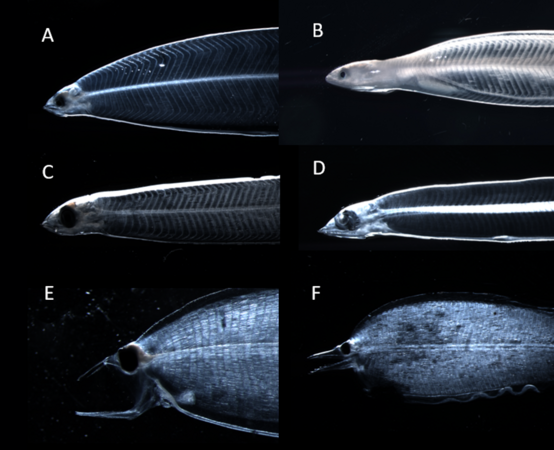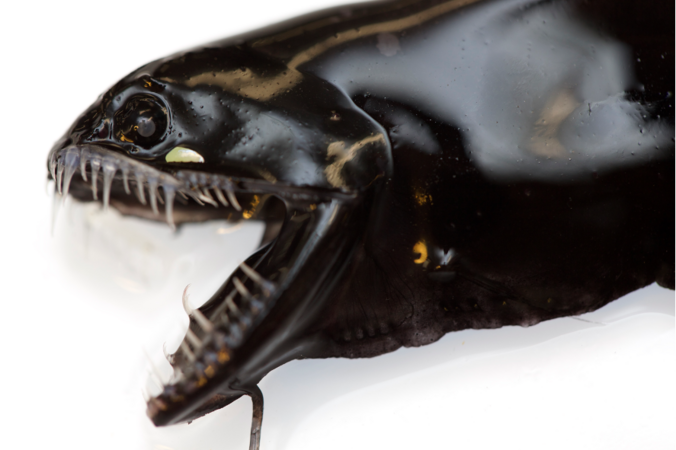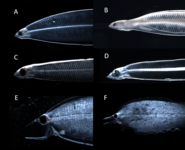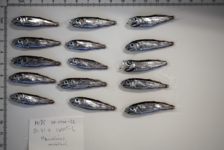ASSOCIATE
Project
Occurrence and distribution of European eel larvae in the Bay of Biscay and around the Iberian Peninsula
![[Translate to English:]](/media/institute/fi/Biodiversitaet_und_Wanderfische/Gruppenfoto_TI.jpeg)
Assesing oceanic impacts on arrival and transport of European eel larvae
Fifty years ago, a series of ichthyoplankton surveys started mainly with the German research vessel Friedrich Heincke in the Bay of Biscay and around the Iberian Peninsula with the primary objective to obtain a detailed overview of abundance, geographical distribution and growth of larvae of the European eel and other anguilliform fishes. The results of these studies provide an ideal basis for comparison with the present situation following the dramatic population collapse of this enigmatic species.
Background and Objective
During this interdisciplinary survey the abundance and distribution of larvae of the European eel along the shelf slope is investigated. Comparison with historical data from the study area will provide information on changes in the occurrence of this endangered species. Further it is planned to assess the pelagic food web along the Iberian continental slope into the Gibraltar strait, which also helps to define the food web position of eel larvae arriving in Europe. Subsequent stable isotope analyses and state-of-the-art DNA metabarcoding analyses will substantially increase our knowledge on diet com-position and feeding ecology of leptocephalus larvae at a pre-settlement stage. This will enable a better understanding of causes of larvae mortality and potential changes in condition of eel larvae compared to the re-cent past. In addition, the occurrence of microplastics in epi- and mesopelagic fish is to be examined and compared with data from neigh-boring bioregions.
Approach
The abundance of European eel larvae was investigated along a latitudinal oceanic gradient from the Bay of Biscay to Morocco and into the western Mediterranean Alboran Sea. Along a grid of regularly spaced sampling stations, the regional and vertical distribution of Anguillid leptocephalus larvae but also of the accompanying zooplankton communities was studied with Isaacs-Kidd Midwater Trawl catches of different mesh sizes. Upper-ocean velocities (from the sea surface to more than 1600 m depth) were measured and recorded along the cruise track by a vessel-mounted 38 kHz Acoustic Doppler Current Profiler (ADCP). CTD data were recorded at all stations. The CTD was also used to collect water samples for subsequent environmental DNA (eDNA) analysis.
Our Research Questions
- Study of abundance, distribution and size of European eel larvae in the Bay of Biscay and around the Iberian Peninsula in comparison with previous surveys.
- Analysis of food sources and feeding ecology of European eel larvae
- Study of the leptocephalus community in the research area
- Analysis of microplastic in epi- and mesopelagic fish and leptocephalus larvae
Results
The distribution of European eel (Anguilla anguilla) and other anguilliform leptocephalus larvae was investigated at 48 stations. In total, 86 leptocephalus larvae of five families were caught including 31 European eel larvae. Anguilla anguilla larvae were caught at 12 stations between the Northwestern coast of the Iberian Peninsula and the Mediterranean Sea, while no eel larvae were caught in the Bay of Biscay, where the planned sampling effort was reduced due to bad weather conditions. While most Anguilla larvae were caught in numbers between 1-3 per station, exceptional high catches were made in the Strait of Gibraltar, caused by the special geographic and hydrographic conditions in that area. Tissue and gut samples from all specimens were taken for subsequent analyses on their feeding ecology and a detailed analysis of ADCP data and eel larvae distribution will provide additional information on their drift routes. Besides Anguilla larvae, leptocephalus larvae of congrid larvae were most abundant in catches and also larvae of Cutthroat eels (Synaphobranchidae), Bobtail snipe eels (Cyematidae) and Pelican eels (Eurypharyngidae) were repeatedly caught.
For the study of microplastics in deep-sea fish, 476 fish were caught with 30 IKMT hauls and preserved for later analysis at the institute.
Thünen-Contact

Involved Thünen-Partners
Involved external Thünen-Partners
-
Universität Bremen
(Bremen, Deutschland) - AZTI-Tecnalia (Marine and Food Technological Centre. The Marine Research Division) / Fundación AZTI
(Bilbao, Sukarrieta, Spanien) -
University of St Andrews
(St. Andrews, Großbritannien (inkl. Nordirland)) -
Universidad de Las Palmas de Gran Canaria
(Las Palmas de Gran Canaria, Spanien) -
Ruđer Bošković Institut
(Zagreb, Kroatien) -
Karls-Universität Prag
(Prag, Tschechische Republik) -
National Oceanography Centre Southampton (NOC)
(Southampton, Großbritannien (inkl. Nordirland)) -
Universität Lissabon
(Lissabon, Portugal)
Funding Body
-
Federal Ministry of Education and Research (BMBF)
(national, öffentlich) -
Deutsche Forschungsgemeinschaft (DFG)
(national, öffentlich)
Duration
8.2022 - 12.2024
Publications
- 0
Freese M, Marohn L, Ferrer L, Pohlmann J-D, Wysujack K, Blancke T, Hanel R (2025) Details on the transport of European eel larvae through the Strait of Gibraltar into the Mediterranean Sea. Sci Rep 15:1006, DOI:10.1038/s41598-024-82929-z
- 1
Marohn L, Wysujack K, Freese M, Pohlmann J-D, Blancke T, Hanel R (2025) Long-term reduction of late-stage European eel larval abundance at the continental slope reflects glass eel recruitment decline. ICES J Mar Sci 82(3):fsaf020, DOI:10.1093/icesjms/fsaf020
- 2
Hanel R, Freese M, Marohn L, Auel H, Blazina M, Claver C, Couret M, Diaz-Pérez J, Ferrer L, Konvicková Z, Major W, Pohlmann J-D, Rommel ACM, Williams J, Wysujack K (2023) Assessing oceanic impacts on arrival and transport of European eel larvae, Cruise No. M185, 29.10.2022 - 26.11.2022, Hamburg (Germany) - Lisbon (Portugal) [online]. Bonn, 52 p, Meteor-Berichte (M185), zu finden in <https://doi.org/10.48433/cr_m185> [zitiert am 31.08.2023], DOI:10.48433/cr_m185
- 3
Hanel R, Schlundt M, Freese M, Marohn L, Pohlmann J-D, Wysujack K (2023) Continuous thermosalinograph oceanography along RV Meteor cruise track M185 [Datenpublikation] [online]. Bremerhaven: PANGAEA, zu finden in <https://doi.pangaea.de/10.1594/PANGAEA.960971> [zitiert am 31.08.2023], DOI:10.1594/PANGAEA.960971

![[Translate to English:] [Translate to English:]](/media/_processed_/2/9/csm_Embryo-Exp_Gelege_9F_dpf5-200513111619_c8534a8199.jpg)
![[Translate to English:] [Translate to English:]](/media/_processed_/2/9/csm_Embryo-Exp_Gelege_9F_dpf5-200513111619_9027994d44.jpg)
















